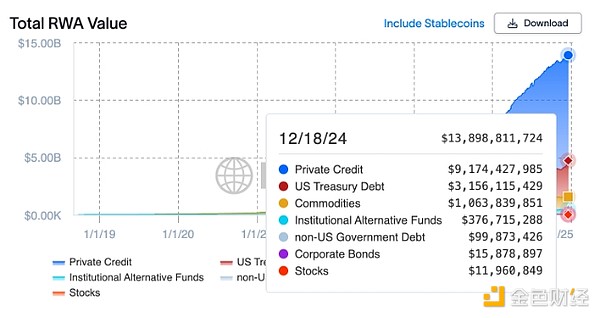
Author: Ana Paula Pereira, CoinTelegraph; Compiled by: Deng Tong, Golden Finance
2024 will be remembered as a landmark year in the history of cryptocurrency. From the surge in mainstream demand for Bitcoin-regulated financial products to the White House's expected friendliness toward the cryptocurrency, the Web3 industry has made significant progress despite facing notable challenges along the way.
With its resilience finally paying off, the industry now sets its sights on another promising year as hopes for regulatory clarity combine with years of innovation and development.
Experts are paying close attention to emerging trends that not only promise to redefine the cryptocurrency landscape, but also impact the entire world.
RWA: Use cases to watch in 2025If you’ve never heard of it, take note of this term: tokenization. It refers to the art of converting traditional assets into tokens, making them tradable, even in small fractions.
In 2024, developers, investors, and companies from all industries are attracted by the tokenization of real-world assets (RWA) craze as it provides a way for traditionally illiquid assets such as real estate. Unlocking liquidity and allowing people around the world to access investments not always available to small investors.
“RWA is a use case to watch in 2025. The value of tokenized assets will double this year,” predicts Sergey Gorbunov, CEO of Interop Labs and co-founder of Axelar Network.
Venture capital firm a16z echoes Gorbunov’s sentiments. "Tokenizing unconventional assets could redefine revenue streams in the digital age," the venture capital firm said in its annual report on cryptocurrency and blockchain industry trends.
According to RWA. According to xyz data, the total value of tokenized assets is currently close to $13.9 billion, a 67% increase from $8.3 billion in January.
On-chain real-world assets are currently worth over $13.8 billion. Source: RWA.xyz
Financial institutions are currently studying risk frameworks for tokenized assets. In other words, they want to ensure compliance with legal requirements and address security risks and market volatility. According to Gurbunov: "Several large financial institutions will develop the risk framework required to issue RWA that can move between interconnected public blockchains."
Identity checking through artificial intelligence agentsOver the past few years , several protocols have been working on how to provide authentication on-chain.
One of the advances in this field is undoubtedly the emergence of zero-knowledge (ZK) proofs, a technology that allows humans toProve yourself without disclosing any personal information. Startups developing this technology include Worldcoin, ONCHAINID, and RisedID, among others.
Looking ahead, on-chain biometric verification is expected to be increasingly powered by artificial intelligence. In other words, AI will automatically check your identity on-chain. This may sound like something out of a science fiction movie, but it’s just one example of the convergence of artificial intelligence and blockchain.
“We expect automated biometrics and/or ID checks to become the norm rather than the exception,” said Civic CEO Chris Hart. He continued:
“As AI agents increasingly act on behalf of users, strong authentication and authorization frameworks are critical to control what these agents can do and for how long — —Especially in financial transactions.”
DePIN is about to take offCommunity-driven energy services, online storage and internet connectivity are already a reality through the decentralized physical infrastructure network (DePIN).
DePIN allows users to become stakeholders in the network, meaning they can own a portion of the infrastructure they use, creating new opportunities for financial inclusion.
Borderless Capital, a venture capital firm that has poured millions of dollars into the DePIN protocol, claims the industry has the "most compelling opportunity" in Web3.
Borderless partner Álvaro Gracia pointed out: "It is the only Web3 vertical industry that can generate revenue and fundamentals that are not related to the cryptocurrency market and can provide real-world value."
According to data compiled by DePIN.Ninja, the market value of the DePIN protocol has exceeded $50 billion.
Bitcoin brings more gainsFinally, it’s impossible to discuss 2025 without mentioning Bitcoin. Once a somewhat disreputable asset, Bitcoin has made significant progress over the past decade, gaining widespread acceptance on Wall Street and cementing its place in the financial world.
While developers are still working to upgrade the network, which now has more stakeholders than ever before, startups are exploring other ways to unlock benefits for holders.
“This is a natural demand from holders, both retail and institutional. This is a native demand from holders,” said Kevin He of Bitlayer, which is backed by asset manager Franklin Templeton Bitcoin layer 2 protocol.
According to He, not only investors, but also large BTC holders such as MicroStrategy are also looking for opportunities through the integration of Bitcoin and decentralized finance.Find additional sources of income.
Bitcoin holders will soon be able to earn up to 40% annual returns on their holdings, according to He.












